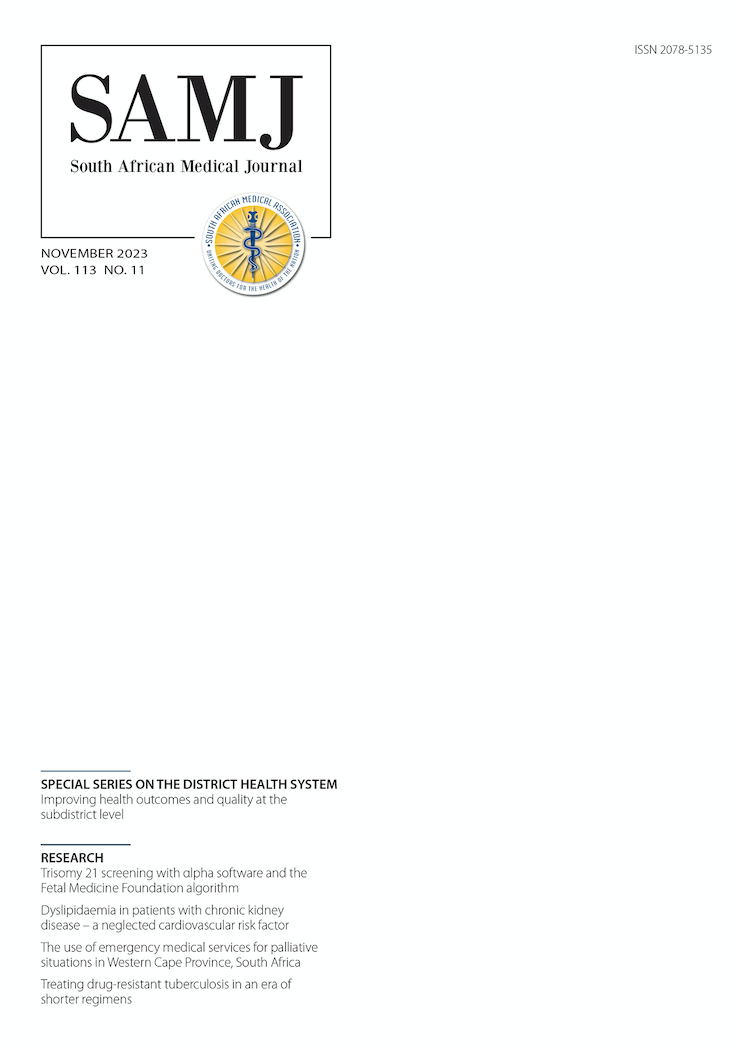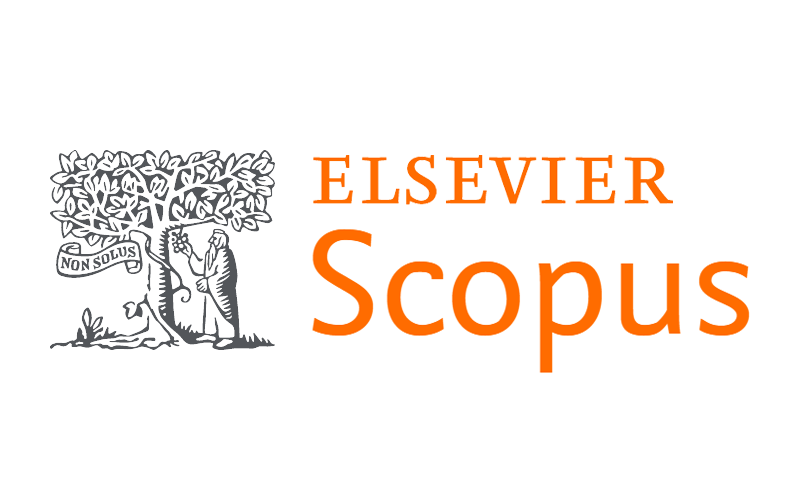Improving health outcomes and quality at the subdistrict level: Evaluation of the ‘3 feet model’ in Waterberg District, Limpopo Province, South Africa
DOI:
https://doi.org/10.7196/SAMJ.2023.v113i11.1558Keywords:
District health system, quality improvement, outcomes, sub-districtAbstract
Background. There is a gap in understanding of potential roles and actions at the subdistrict level to improve quality of care and health outcomes in South Africa (SA).
Objectives. To report on the evaluation of a subdistrict health system-strengthening initiative that aimed to reduce maternal, newborn and child mortality, referred to as the ‘3 feet model’ in Waterberg District, Limpopo Province, SA. The model is centred on systems of real-time morbidity/mortality surveillance and co-ordinated responses. It was implemented in three of five Waterberg subdistricts over an 18-month period in 2021 and 2022.
Methods. A prospective, process-tracing evaluation was conducted jointly between researchers, intervention partners and subdistrict decision-makers. Data sources combined ~100 hours of researcher participant observation, interviews with 14 health system actors, structured reflections by three subdistrict managers and information from the routine District Health Information System. Sources were triangulated and analysed based on a priori hypotheses on mechanisms of action.
Results. Following uptake of the model, the perinatal mortality rate (PMR) improved by 28.8%, 11.5% and 28% in the three subdistricts, respectively, while the PMR worsened in two of four neighbouring subdistricts. Plausible factors in implementation successes were the presence of stable and committed hybrid (clinical-managerial) subdistrict leaders and their ability to overcome entrenched silos between a variety of system actors; new collaborative relationships between primary healthcare facilities, hospitals and emergency medical services; the generation and packaging of information in ways that directed responses (‘actionable intelligence’); and support from senior district managers.
Conclusion. While not advocating for a cut-and-paste approach to improving quality and outcomes, positive experiences in Waterberg District suggest that the principles and mechanisms of action of the 3 feet model have wider relevance for policy and practice, especially as emphasis shifts towards the subdistrict as a core unit of population health and wellbeing in SA.
References
South Africa. National Health Act No. 61 of 2003.
Tarimo E. Towards a health district: Organizing and managing district health systems based on
primary health care. Geneva: World Health Organization, Division of Strengthening of Health
Services, 1991. https://iris.who.int/handle/10665/40785 (accessed 22 September 2023).
South Africa. National Health Insurance Bill B-11, 2019.
South African Lancet National Commission. Confronting the right to ethical and accountable
quality health care in South Africa: A consensus report. Pretoria: National Department of Health, 2019. https://bhekisisa.org/wp-content/uploads/2019/07/620a9eb9-final-sa-lnc-report.pdf (accessed 22 September 2023).
Prinsen L. Medicine and the law. S Afr Med J 2023;113(4):e134. https://doi.org/10.7196/SAMJ.2023. v113i4.134
Schneider H, Mianda S. District and subdistrict stewardship of quality and health outcomes: Roles, systems and strategies (briefing document). Cape Town: University of the Western Cape, 2022. https:// repository.uwc.ac.za/xmlui/handle/10566/7498 (accessed 22 September 2023).
Schneider H, George A, Mukinda F, Tabana H. District governance and improved maternal, neonatal and child health in South Africa: Pathways of change. Health Syst Reform 2020;6(1):1-12. https://doi. org/10.1080/23288604.2019.1669943
Cupido J. Development of the 3 Feet Model: A Bottom-Up and System Wide Approach to Reducing Mortality and Morbidity. Cape Town: University of the Western Cape, 2021.
Wessels J, Cupido J. Health Systems Strengthening at the Sub-district Level: The Three Feet Model. An Implementation Guide. Johannesburg: Clinton Health Access Initiative, 2021.
Schneider H, McKenzie A, Tabana H, Mukinda F, George A. Evaluation of health system strengthening initiatives for improving the quality and outcomes of maternal, neonatal and child health care in four South African districts (report). Cape Town: School of Public Health, SAMRC Health Services to Systems Research Unit, University of the Western Cape, 2017.
SchneiderH,vanderMerweM,MarutlaB,CupidoJ,KauchaliS.Thewholeismorethanthesumof the parts: Establishing an enabling health system environment for reducing acute child malnutrition in a rural South African district. Health Policy Plan 2019;34(6):430-439. https://doi.org/10.1093/ heapol/czz060
Rothgang M, Lageman B. The unused potential of process tracing as evaluation approach: The case of cluster policy evaluation. Evaluation 2021;27(4):527-543. https://doi.org/10.1177/135638902110416 13. Beach D, Pedersen R. Process-Tracing Methods: Foundations and Guidelines. Ann Arbor: University
of Michigan Press, 2013. https://doi.org/10.3998/mpub.10072208
Portela MC, Pronovost PJ, Woodcock T, Carter P, Dixon-Woods M. How to study improvement
interventions: A brief overview of possible study types. BMJ Qual Saf 2015;24(5):325-336. https://doi.
org/10.1136/bmjqs-2014-003620
Barry D, Kimble LE, Nambiar B, et al. A framework for learning about improvement: Embedded implementation and evaluation design to optimise learning. Int J Qual Health Care 2018;30(suppl 1):S10-S14. https://doi.org/10.1093/intqhc/mzy008
Mukinda FK, van Belle S, Schneider H. Local dynamics of collaboration for maternal, newborn and child health: A social network analysis of healthcare providers and their managers in Gert Sibande District, South Africa. Int J Health Policy Manag 2021:1-11. https://doi.org/10.34172/ijhpm.2021.106
Kinney MV, George AS, Rhoda NR, Pattinson RC, Bergh AM. From pre-implementation to institutionalisation: Lessons from sustaining a perinatal audit program in South Africa. Glob Health Sci Pract 2023;11(2):e2200213. https://doi.org/10.9745/GHSP-D-22-00213
Thelen J, Sant Fruchtman C, Bilal M, et al. Development of the Systems Thinking for Health Actions framework: A literature review and a case study. BMJ Glob Health 2023;8(3):e010191. https://doi. org/10.1136/bmjgh-2022-010191
Carmone AE, Kalaris K, Leydon N, et al. Developing a common understanding of networks of care through a scoping study. Health Syst Reform 2020;6(2):e1810921. https://doi.org/10.1080/232886 04.2020.1810921
Sheikh K, Abimbola S. Learning health systems: Pathways to progress. Flagship report of the Alliance for Health Policy and Systems Research. Geneva: World Health Organization, 2021. https://ahpsr.who.int/publications/i/item/learning-health-systems-pathways-to-progress (accessed 22 September 2023).
McGivern G, Currie G, Ferlie E, Fitzgerald L, Waring J. Hybrid manager-professionals’ identity work: The maintenance and hybridisation of medical professionalism in managerial contexts. Pub Admin 2015;93(2):412-432. https://doi.org/10.1111/padm.12119
Nzinga J, McGivern G, English M. Examining clinical leadership in Kenyan public hospitals through the distributed leadership lens. Health Policy Plan 2018;33(suppl 2):ii27-ii34. https://doi.org/10.1093/ heapol/czx167
Engelbrecht B, Gilson L. Governance, leadership and management. In: Matsoso MP, Chikte U, Makubalo L, Pillay Y, Fryatt R, (eds). The South African Health Reforms 2015 - 2020. Johannesburg: Trackstar Trading, 2022:291-312.
Downloads
Published
Issue
Section
License
Copyright (c) 2023 H Schneider, F Mukinda, J Cupido, J Wessels, P Kupa, P Leboho, N Nkoana, N Bosch, Y Pillay

This work is licensed under a Creative Commons Attribution-NonCommercial 4.0 International License.
Licensing Information
The SAMJ is published under an Attribution-Non Commercial International Creative Commons Attribution (CC-BY-NC 4.0) License. Under this license, authors agree to make articles available to users, without permission or fees, for any lawful, non-commercial purpose. Users may read, copy, or re-use published content as long as the author and original place of publication are properly cited.
Exceptions to this license model is allowed for UKRI and research funded by organisations requiring that research be published open-access without embargo, under a CC-BY licence. As per the journals archiving policy, authors are permitted to self-archive the author-accepted manuscript (AAM) in a repository.
Publishing Rights
Authors grant the Publisher the exclusive right to publish, display, reproduce and/or distribute the Work in print and electronic format and in any medium known or hereafter developed, including for commercial use. The Author also agrees that the Publisher may retain in print or electronic format more than one copy of the Work for the purpose of preservation, security and back-up.





